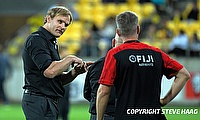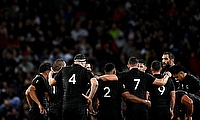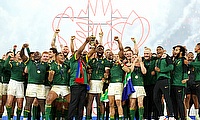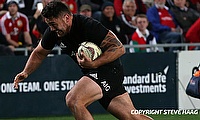Should Northern Hemisphere clubs use NZ more for development
If you have been paying attention to New Zealand’s premiere domestic rugby competition, the Mitre 10 Cup, you’ll have noticed a number of English players plying their trade there over the past few seasons.
Formerly known at the ITM Cup, the competition has seen the likes of Matt and Andy Symons grace it in recent years, with Matt Symons going on to captain the Chiefs in Super Rugby before returning to England with London Irish (and now Wasps) in a bid to forge an international career. Andy headed home two years earlier than his brother, signing for Worcester Warriors in 2013, before making the move to Gloucester this summer.
The pair came through the Saracens academy before deciding to push forward their careers in New Zealand and that’s a similar path to the one that fellow Saracens graduate Piers Francis has also taken. After emerging from the club’s academy, Francis had stints with Auckland and Waikato before trying his luck back in the UK with Edinburgh and Doncaster Knights. Neither move really worked out for Francis and he headed back south in 2015.
This second stint in New Zealand saw him play for Counties Manukau and link-up with their then-coach Tana Umaga. The former All Black centre clearly saw something he liked in Francis and has since brought the Englishman with him to the Blues, where he now regularly lines up as a starting inside centre in Super Rugby.
It’s not just the latest trend, either. Going back to the days of amateur rugby, England’s World Cup-winning captain Martin Johnson served an apprenticeship in the Land of the Long White Cloud, even representing the New Zealand U21 side during his time there. When professionalism came in, the players were still sent to New Zealand, tapping into the country’s wealth of rugby knowledge, but usually as teenagers, featuring at age-grade or the tier below the national championship, with Tom Wood one of the higher profile players to tread this path.
The latest to make the move, albeit on a temporary basis, is former England U20 sensation Nathan Earle. The flyer has made a loan move to Canterbury this year and has started for the South Island side in two of their games so far this season. Injuries and a star-studded Saracens squad have limited Earle’s opportunities since he set the Junior World Championship alight in 2014 but he will be hoping that a stint in the Mitre 10 Cup can give him the confidence and form to challenge the senior players at Saracens when he returns later this year.
Time will tell if the move works out for Earle, but it certainly helped develop the skill sets of both the Symons brothers and Francis, the latter of whom is beginning to attract a lot of Premiership attention with his displays for the Blues.
As pathways go, it’s one which is arguably underused by English clubs.
Some U20 players are lucky enough to make a seamless transition from the age-grades to senior club rugby, but for the majority, they face dual-registration in the Greene King IPA Championship or National Leagues and plenty of ‘A’ rugby in the Premiership’s reserve league. Both the Championship and ‘A’ league are fine competitions but neither is played at the standard that the Mitre 10 Cup is. Again, some former age-grade and academy players will be able to make the impact they need in the Championship or ‘A’ league and propel themselves into the senior squad, but many are left on the fringes.
Lewis Ludlam was a force of nature at the breakdown in the 2015 World Rugby U20 Championship but due to the presence of Wood, Teimana Harrison, Calum Clark, Jamie Gibson and new arrival Louis Picamoles in Northampton’s back row corps, Ludlam’s opportunities are scarce to say the least. A loan spell in New Zealand could do wonders for his development, especially given the different way the breakdown is refereed in the southern hemisphere, where precision is key. It’s not always true but the general rule of thumb is that if you prosper at the breakdown in the southern hemisphere, you should do pretty well in the north.
Fellow Northampton man Jordan Onoajife is a player in a similar boat to Ludlam, as are Exeter’s Stuart Townsend, Wasps’ Will Stuart and Saracens’ duo of Joel Conlon and Henry Taylor. All of these players have the ability to be effective players in the Mitre 10 Cup and there are teams in the competition that would improve their first XVs by bringing them on board for the season.
It’s not just English players and clubs who could benefit from more regular link-ups with New Zealand sides. Leinster’s Billy Dardis was a prodigious talent coming through the age-grades and there are certainly similarities with fellow full-back Damian McKenzie, who has been taking the world by storm this season. A season spent in the Mitre 10 Cup would surpass anything Dardis could hope to achieve in the British and Irish Cup or with Leinster’s ‘A’ side, potentially moving on his kicking and defensive abilities to a point where he could challenge the regulars in the Leinster senior side.
Newport Gwent Dragons’ Harri Keddie, Leinster’s Ross Byrne and Glasgow’s Scott Cummings are just a few further examples of players who have an abundance of ability and who now need senior games to push forward their development.
Of course, it’s not a given that every player would be wanted or required by one of the Kiwi clubs but it’s a pathway which should be explored more thoroughly by Premiership and PRO12 teams. For individuals just unable to crack those senior squads in both competitions but who have the talent to be very effective players, it could represent their best chance of realising their potential.








